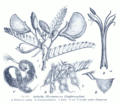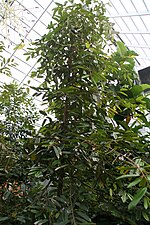There is a page named "Psilate" on Misplaced Pages
- Psilate an article on "psilate", but its sister project Wiktionary does: Read the Wiktionary entry "psilate" You can also: Search for Psilate in Misplaced Pages to... 328 bytes (0 words) - 01:14, 9 January 2022
 Acalypha vermiform; pollen grains oblate-spheroidal, with 3–5 pseudopores, tectate, psilate; pistillode absent. Female flowers generally sessile or subsessile, pedicellate... 23 KB (2,517 words) - 09:46, 2 January 2025
Acalypha vermiform; pollen grains oblate-spheroidal, with 3–5 pseudopores, tectate, psilate; pistillode absent. Female flowers generally sessile or subsessile, pedicellate... 23 KB (2,517 words) - 09:46, 2 January 2025- Exallosperma elevation. The genus is distinguished within tribe Pavetteae by pollen with psilate tectum, and by fruit with two stony pyrenes. Each pyrene contains a laterally... 2 KB (198 words) - 20:58, 10 November 2023
- Hylaeaicum margaretae irregular infoldings. The apertures on the pollen's surface are porus and psilate, lacking ornamentation. The grains lack orbicules. Hylaeaicum margaretae... 4 KB (391 words) - 02:53, 14 May 2024
 Karuka flowering organ may be up to 2 metres (6 ft 7 in) long. The pollen has a psilate exine (unornamented outer wall) 0.8 μm thick. The ornamentation is granular... 38 KB (3,588 words) - 05:07, 24 November 2024
Karuka flowering organ may be up to 2 metres (6 ft 7 in) long. The pollen has a psilate exine (unornamented outer wall) 0.8 μm thick. The ornamentation is granular... 38 KB (3,588 words) - 05:07, 24 November 2024 Aeschynomene elaphroxylon view; 3-colporate, colpus very long, operculum areolate, membrane psilate, margo psilate-perfurate; endoaperture circular, lalongate to lolongate, sexine... 44 KB (4,989 words) - 04:26, 20 May 2024
Aeschynomene elaphroxylon view; 3-colporate, colpus very long, operculum areolate, membrane psilate, margo psilate-perfurate; endoaperture circular, lalongate to lolongate, sexine... 44 KB (4,989 words) - 04:26, 20 May 2024 Durio graveolens stigma and white to greenish style about 48 mm (1.9 in). The pollen is psilate (relatively smooth), spheroidal, and 54 μm (0.0021 in) in diameter. The... 38 KB (3,365 words) - 06:26, 2 November 2024
Durio graveolens stigma and white to greenish style about 48 mm (1.9 in). The pollen is psilate (relatively smooth), spheroidal, and 54 μm (0.0021 in) in diameter. The... 38 KB (3,365 words) - 06:26, 2 November 2024- Phytic era polyplicate pollen forms were common, but were later replaced by simple, psilate gymnosperm pollen grains. The Cenophytic begins well before the Cenozoic... 4 KB (478 words) - 04:23, 24 March 2022
- George Moschabar Semitic extraction. He also seems to have borne the name "Psyllos" or "Psilates." He was often referred to, ironically, as "the philosopher" or "the Aristotelian... 6 KB (756 words) - 10:42, 31 October 2024
- Word definitions from Wiktionarypsilate incomplete. Please add to it, or discuss it at the Etymology scriptorium.) psilate (not comparable) (botany, of a pollen grain wall) Lacking ornamentation;See all results